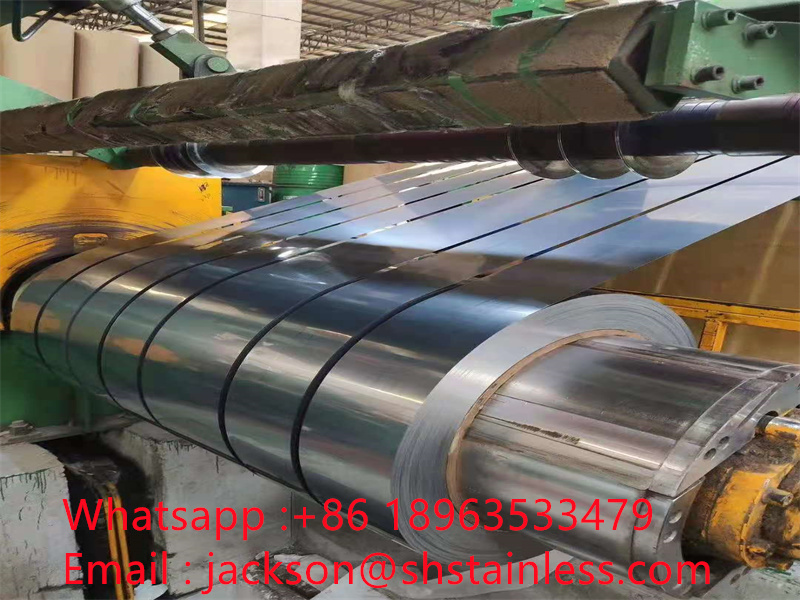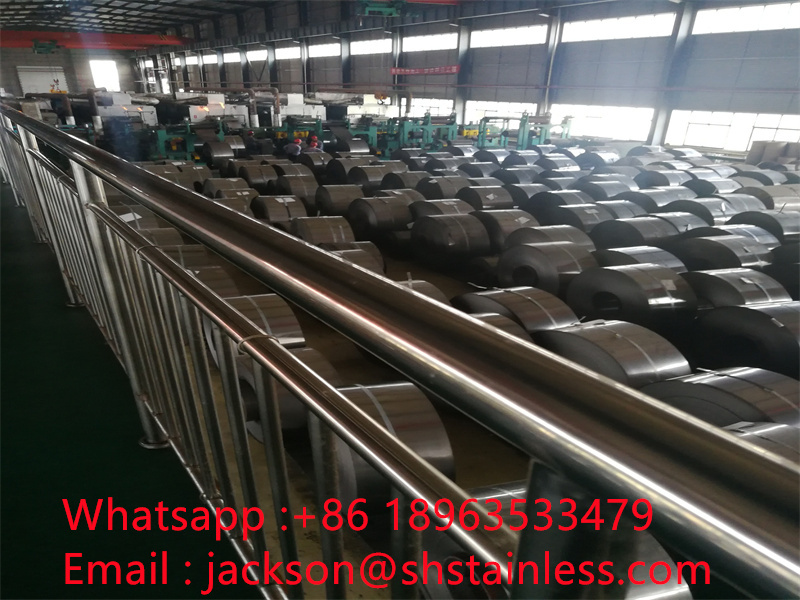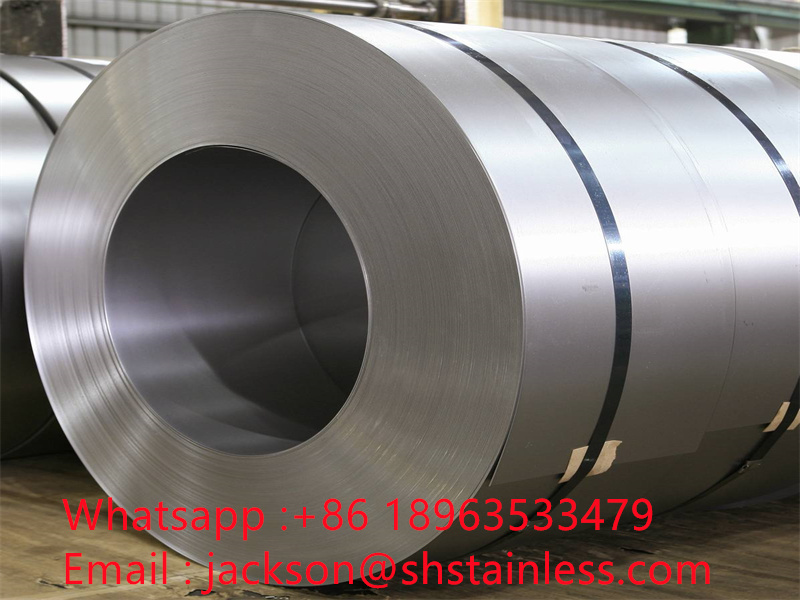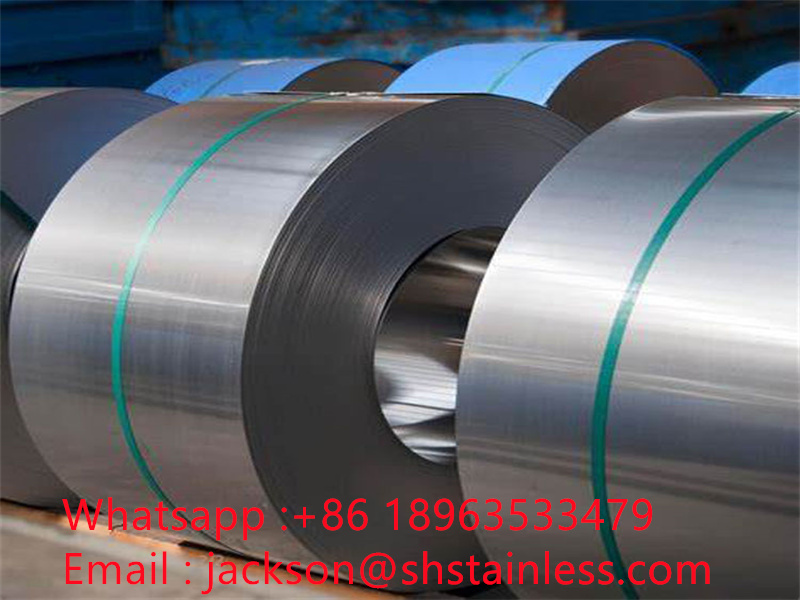American Steel Products’ assembly and testing facility features a four-level leveling system that can process panels from 0.25 to 6 inches thick and up to 160 inches wide.
Most metalworking industries know the importance of proper alignment. The process used in sheet metal fabrication plants creates sheet metal with retained stress, which is essentially a tug-of-war of stress and pressure. When these forces are balanced in all directions of the plate, the plate becomes flat.
To achieve this balance, web converters can use a variety of corrective alignment techniques—tension alignment, release alignment, and even tension alignment—but roller alignment remains the dominant technology.
Product Description
| Name | Stainless Steel coil/ sheet |
| Standard | JIS, AiSi, ASTM, GB, DIN, EN |
| Material | 201/202/304/304L/316/316L/316H/316Ti/410/430/2205/2507/904L/347/317L/Or Customized |
| Surface | BA/2B/NO.1/NO.4/4K/HL/8K/EMBOSSED or according to customer requirementg,etc. |
| Thickness | 0.3mm-70mm or as customer’s requests |
| Width | 30mm-2000mm or as customer’s requests |
| Length | As customer’s request |
| Inspection | Fully accept all the third party to test before shipment. |
| Packing | Standard Export Seaworthy Package.Suit for all kinds of transport,or according to client’s requirement. |
| Payment Terms | L/C, T/T |
Chemical Composition
| Grade | C(Max) | Mn(Max) | P(Max) | S(Max) | Si(Max) | Cr | Ni | Mo | N(Max) | Cu/Others |
| 304 | 0.08 | 2.00 | 0.045 | 0.030 | 1.000 | 18.00-20.00 | 8.00-10.50 | - | 0.10 | - |
| 304L | 0.030 | 2.00 | 0.045 | 0.030 | 1.000 | 18.00-20.00 | 8.00-12.00 | - | 0.10 | - |
| 310S | 0.08 | 2.00 | 0.045 | 0.030 | 1.500 | 24.00-26.00 | 19.00-22.00 | - | - | - |
| 316 | 0.080 | 2.00 | 0.045 | 0.030 | 1.000 | 16.00-18.00 | 10.00-14.00 | 2.00-3.00 | - | - |
| 316L | 0.030 | 2.00 | 0.045 | 0.030 | 1.000 | 16.00-18.00 | 10.00-14.00 | 2.00-3.00 | 0.10 | - |
| 409 | 0.08 | 1.00 | 0.040 | 0.010 | 1.000 | 10.50-11.75 | 0.50 | - | - | Ti=6x(C+N) |
| 430 | 0.12 | 1.00 | 0.040 | 0.030 | 1.000 | 16.00-18.00 | 0.75 | - | - | - |
| 904L | 0.02 | 2.00 | 0.045 | 0.035 | 1.00 |
19.00-23.00 |
23.00-28.00 | 4.00-5.00 | - | 1.00-2.00 |
Mechanical Property |
|||||
| Grade | State | Hardness HV | Yield Strength | Tensile Strength | Elongation(%) |
| SUS304 | ANN | <200 | >205 | >520 | >40 |
| 1/4H | 200-250 | >255 | >550 | >35 | |
| 1/2H | 250-310 | >470 | >780 | >6 | |
| 3/4H | 310-370 | >665 | >930 | >3 | |
| H | 370-430 | >880 | >1130 | – | |
| SUS301 | ANN | <250 | >205 | >520 | >40 |
| 1/4H | 250-310 | >470 | >780 | >35 | |
| 1/2H | 310-370 | >510 | >930 | >10 | |
| 3/4H | 370-430 | >745 | >1130 | >5 | |
| H | 430-490 | >1030 | >1320 | >3 | |
| EH | 490-550 | >1275 | >1570 | – | |
| SH | >550 | >1500 | >1850 | – | |
| SUS201 | ANN | <200 | >205 | >515 | >40 |
| 1/4H | 200-250 | >250 | >550 | >35 | |
| 1/2H | 250-310 | >470 | >780 | >6 | |
| 3/4H | 310-370 | >665 | >930 | >3 | |
| H | 370-430 | >880 | >1130 | – | |
| SUS430 | ANN | <200 | >205 | >450 | >22 |
| 1/2H | 200-250 | >330 | >505 | >10 | |
| H | 250-310 | >420 | >750 | >6 | |
| SUS443 | ANN | <200 | >305 | >483 | >31 |
| SUS310S | ≤200 | <200 | >205 | >520 | >40 |
| SUS316L | ≤200 | <200 | >310 | >620 | >40 |
Product Photos :
Most corrective leveling methods focus on sheet metal 0.25 inches thick and thinner, but what about sheet metal leveling? Anyone who works in demanding manufacturing environments, such as making large storage tanks or working with pressure vessels that require heavy rolling, knows the challenges faced when cutting or forming sheet material to relieve stress. The process becomes more unpredictable. But technology that flattens sheets of material, sometimes up to 6 inches thick, could help make heavy manufacturing more predictable, faster and less costly.
The need to level slabs has been around for decades. The several-inch-thick plates intended for pre-World War II ships and submarines had to be flattened before production began, so they had to be leveled, which was usually done in a factory. Over the years, as materials have become more complex, sheet alignment has become more important. Prominent examples are tanks and ships, as well as other products produced over the years for oil fields, gas plants, water industries, food processing plants, bridge construction, etc.
Some food and chemical applications use composite plates that contain a thick carbon steel base metal section and a stainless steel cladding layer on the inside diameter to prevent corrosion and acidic chemical reactions on the inside wall while allowing components to be welded to the carbon surface. External diameter. steel. Some tanks are lined with rubber or glass. Large diameter pipes made from high-strength sheet material, critical for offshore drilling, also require alignment.
Some manufacturers use very thick stainless steel or even sheets of multiple alloys fused together. For example, Dynamic Materials Corp. fuses 0.25″ thick stainless steel to up to 3″ thick carbon steel. This is not surprising since the company, whose stock symbol is “BOOM”, fuses stainless steel with carbon in underground chambers using a unique explosion welding method. All this creates an exceptionally strong and thick slab that must be leveled before cutting and shaping in the production shop.
In all of these works, 0.25 inches is considered thin. Most of the board is thick, most of it being several inches thick. Place a 3-inch-thick raw sheet (filled with uneven retained stresses) in a three- or four-roll bender and you have little chance of easily producing a perfect cylinder with the prepared edges touching exactly where the subsequent correct position for welding is. .
Regardless of the process, the process can become more difficult and costly if the operator starts with a sheet that is bent in the middle or has any other form defects. This is why operators first use a long (e.g. 8 foot) straight edge to ensure the sheet is level in all directions before proceeding with forming or fabrication.
Industry sheet flatness standards specify a specific flatness of 0.25 inches. Deviations greater than 8 feet are common characteristics. However, many panel manufacturing operations require tighter flatness tolerances, sometimes a fraction of industry standards. This is where precision plate alignment comes into play.
If a manufacturer or other manufacturer purchases boards that have not been leveled, defects in shape may be immediately noticeable by the person receiving the material. These include a crossbow in width and a smooth curve in length.
Alloy 4340 plate, 150 KSI yield strength, smooth. Large, precisely controlled hydraulic cylinders determine the penetration depth of each roller. The system can level slabs up to 6 inches thick and apply separation forces of up to 6,000 tons.
If you know how a roller leveler processes sheet metal, you will know how a powerful flat leveler processes sheet metal. Most roller leveling machines for gauge material have large alloy support rollers behind the main alloy roller; for example, four-roll machines have support rollers with large roller bearings on the top and bottom. The design reduces roller deflection and allows fine adjustments to produce a uniform, flat material. The sheet passes through the initial roll with maximum penetration, following a so-called differential path around alternating or staggered top and bottom rolls.
Plate straightening machines can exert up to 6,000 tons of pullout force or vertical force generated by rollers. In fact, the forces exerted on powerful steel plate straightening machines exceed even those exerted on rolling mills that produce steel. All this power comes from powerful hydraulic cylinders that exert 10,000 psi of hydraulic pressure.
Most flat plate levelers are four-roll machines with larger support rolls behind the work rolls. The operation of these machines is somewhat similar to that of straight roller machines, but in many ways it is a different animal, primarily due to the range of extreme forces and yield stresses in different areas of a single sheet. Profitability can vary from one section of the board to another and in all directions. This creates the need for adjustments, and this is where sheet leveling differs from traditional roll leveling.
To adjust a roller leveler, the operator adjusts sets of rollers that are connected to each other in the same plane. This does not work at the parameters required for sheet straightening, since sheet straightening typically requires extreme force and there is significant variation in penetration from one roll to the next. Connecting the work rolls during operation limits the penetration of material that the operator can achieve.
To achieve maximum penetration and the precise adjustment required for plate alignment, each roller adjustment is actuated by a dedicated precision-controlled hydraulic cylinder, with each roller adjustable to ±0.001 inch.
Since material yield can vary significantly at different locations along the length and width of the board, adjustability is critical. Some flat plate leveling machines use laser measuring devices during operation. The laser allows the machine to see the condition of the material in real time. Unexpectedly large changes in yield strength will cause certain roll settings to have different effects on the shape of the material; If the laser-measured material position is outside a certain tolerance window, the straightening operation can compensate accordingly.
In a typical sheet flattener, the bending roller creates a uniform bend in both the positive and negative directions. The first few sets of rollers typically have deeper penetration to eliminate warping and equalize stress, essentially “breaking” the sheet, while the last three sets of rollers control the final straightness.
The boards are not always completely flat after one pass through the machine. In some cases, it is passed through the roller once, turned over, and then passed through again. Typically, after the first pass, the board exits the straightener in an upward curve. In a sense, a straightening machine simply replaces various shape imperfections with a uniform curvature, which can then be corrected by passing the sheet through rollers and passing it again for final straightening. Operators typically maintain the same roller settings for the first and return passes. This may be the third time the operator has made the latest breaking changes.
The operator looks at a book that provides numerical settings for a specific yield and thickness of material. But operators need to carefully check the material as it comes out of the first pass. If productivity varies significantly (and this variation may simply be due to the way the sheet is made on the mill (including the hardening process)), the operator may need to make significant adjustments to the correct machine settings for the final pass (or passes).
The slab with the crossbow enters the first pass on a four-roll straightening machine with individual roller adjustment.
Sometimes the operator has to repeat this process two or three times before the board is completely level in all directions. However, the operator usually only needs to move the machine forward, backward and then forward again three times to complete the leveling process.
This is a balancing act as the panel leveler never wants to overload the panel. Excessive processing of materials and their properties may change, making subsequent production difficult or impossible. Given the size and value of the material, over-processing on a flat leveler can result in very expensive scrap. This is why the ability to fine-tune roll parameters is so important, especially for final work rolls.
This fine adjustment on the right machine prevents extremely costly scrap from coming out. In heavy manufacturing, a single piece can cost six figures even before the manufacturer puts any value into it. The flatter the plate, the more consistent subsequent operations will be and the higher the profit and success rate for heavy equipment manufacturers.
Fabricator is the leading magazine for the North American metal fabricating industry. The magazine publishes news, technical articles and case reports that enable manufacturers to do their jobs more efficiently. The manufacturer has been serving the industry since 1970.
Full digital access to The Fabricator is now available, providing easy access to valuable industry resources.
Full access to the digital edition of Tubing Magazine is now available, providing easy access to valuable industry resources.
Full access to the digital version of The Fabricator en Español is now available, providing easy access to valuable industry resources.
Nikita Adikes, fabricator and project manager at CTEK Construction Plant in Orange County, California, talks about her passion…
Post time: Oct-13-2023




